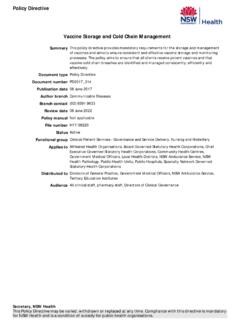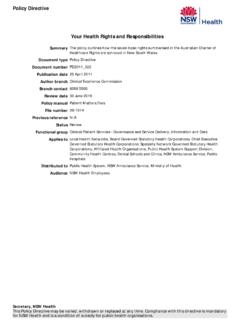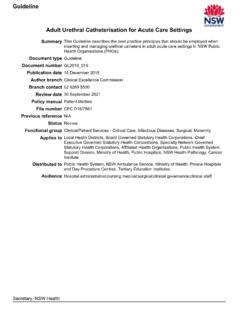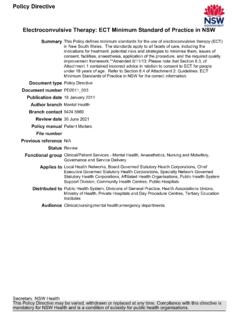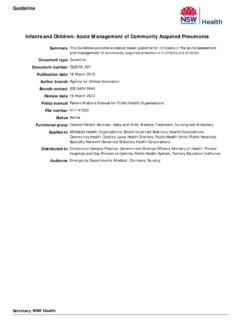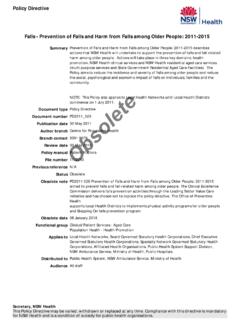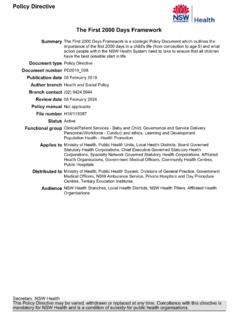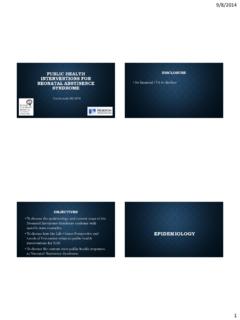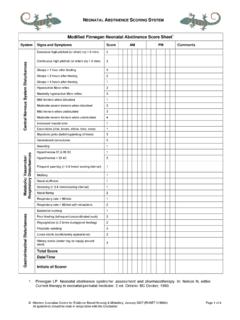Transcription of Neonatal Abstinence Syndrome Guidelines - health.nsw.gov.au
1 GuidelineMinistry of Health, NSW73 Miller Street North Sydney NSW 2060 Locked Mail Bag 961 North Sydney NSW 2059 Telephone (02) 9391 9000 Fax (02) 9391 9101 Abstinence Syndrome GuidelinesspaceDocument NumberGL2013_008 Publication date04-Sep-2013 Functional Sub groupClinical/ Patient Services - Baby and childClinical/ Patient Services - MaternitySummaryThis is to provide guidance for the early detection and engagement of theopioid dependent pregnant woman and new mothers withmulti-disciplinary team care; the care of the newborn child; postnatal careof both the mother and child; and the care and protection responsibilitiesof health workers clinically involved in the care of the Doc.
2 Abstinence Syndrome Guidelines [PD2005_494]Author BranchCentre for Population HealthBranch contactCentre for Population Health 02 9391 9038 Applies toLocal Health Districts, Board Governed Statutory Health Corporations,Chief Executive Governed Statutory Health Corporations, SpecialtyNetwork Governed Statutory Health Corporations, Affiliated HealthOrganisations, Public Health System Support Division, Community HealthCentres, Government Medical Officers, Private Hospitals and DayProcedure Centres, Public HospitalsAudienceClinical, Allied Health, Nursing - Maternity, Neonatal & Paediatric, EarlyChildhood, Drug & AlcoholDistributed toPublic Health System.
3 Divisions of General Practice, GovernmentMedical Officers, Health Associations Unions, NSW Ambulance Service,Ministry of Health, Private Hospitals and Day Procedure Centres, TertiaryEducation InstitutesReview date04-Sep-2018 Policy ManualPatient MattersFile of Health, NSW73 Miller Street North Sydney NSW 2060 Locked Mail Bag 961 North Sydney NSW 2059 Telephone (02) 9391 9000 Fax (02) 9391 9101 Abstinence Syndrome GuidelinesspaceDocument NumberGL2013_008 Publication date04-Sep-2013 Functional Sub groupClinical/ Patient Services - Baby and childClinical/ Patient Services - MaternitySummaryThis is to provide guidance for the early detection and engagement of theopioid dependent pregnant woman and new mothers withmulti-disciplinary team care; the care of the newborn child; postnatal careof both the mother and child; and the care and protection responsibilitiesof health workers clinically involved in the care of the Doc.
4 Abstinence Syndrome Guidelines [PD2005_494]Author BranchMental Health and Drug and Alcohol OfficeBranch contactKate Williamson 9391 9038 Applies toLocal Health Districts, Board Governed Statutory Health Corporations,Chief Executive Governed Statutory Health Corporations, SpecialtyNetwork Governed Statutory Health Corporations, Affiliated HealthOrganisations, Public Health System Support Division, Community HealthCentres, Government Medical Officers, Private Hospitals and DayProcedure Centres, Public HospitalsAudienceClinical, Allied Health, Nursing - Maternity, Neonatal & Paediatric, EarlyChildhood, Drug & AlcoholDistributed toPublic Health System.
5 Divisions of General Practice, GovernmentMedical Officers, Health Associations Unions, NSW Ambulance Service,Ministry of Health, Private Hospitals and Day Procedure Centres, TertiaryEducation InstitutesReview date04-Sep-2018 Policy ManualPatient MattersFile GUIDELINE SUMMARY GL2013_008 Issue date: September-2013 Page 1 of 2 Neonatal Abstinence Syndrome Guidelines PURPOSE These Guidelines specifically address the management of newborns to mothers with a history of opioid use or opioid dependence, including women currently receiving opioid substitution treatment (methadone or buprenorphine) or using prescription pharmaceutical opioids (such as oxycodone, morphine, pethidine or tramadol).
6 While Neonatal Abstinence Syndrome (NAS) is more common in infants born to opioid dependent women than in infants born to women dependent on other drugs, the effect of polydrug use on NAS is not clearly established and is most likely dependent upon the specific combination and quantities of drugs used by the mother. Provided that Neonatal Abstinence Syndrome is appropriately managed, it is not currently known to be associated with long-term health problems. KEY PRINCIPLES The Guidelines concentrate on two main aspects of care: 1. The care of the opioid-dependent pregnant woman from a drug and alcohol perspective based on "Harm Minimisation" principles, and; 2.
7 The care of the newborn from a child protection perspective. These Guidelines should be used to guide clinical management; however clinicians must always consider the pregnant woman they are managing as an individual, and apply the Guidelines appropriately. Opioid dependent pregnant women have an increased risk of experiencing complications during pregnancy and of their infants experiencing adverse outcomes. The association is complex and may be affected by a range of factors including: poly substance use; inadequate antenatal care; poor nutrition; blood borne virus exposure; mental health problems; housing; and domestic violence.
8 Births in mothers with opioid, stimulant or cannabis use diagnoses are associated with a number of negative Neonatal outcomes. Babies are more likely to be born before the gestational age of 37 weeks, to be of low birth weight, and to be admitted to Neonatal intensive care units or to special care nurseries than babies born to mothers without such a diagnosis. Many women are more motivated during pregnancy to make important health and lifestyle changes. This is an ideal time to engage, or more fully engage, a woman in care for her drug use and other problems. A range of services are required to work collaboratively in order to ensure optimal outcomes for both the mother and newborn.
9 The aim is to minimise the likelihood of complications and to provide comprehensive antenatal and postnatal care in a non judgemental, non-threatening environment. USE OF THE GUIDELINE While the focus of these Guidelines is opioid dependent women it is recognised that other illicit drugs such as stimulants, sedatives, alcohol and some psychotropic medications may also be associated with NAS and these women and newborns may have similar care needs. Therefore, the care elements of the Guidelines (which exclude elements specifically relating to opioid pharmacology as found in parts of Sections , and ) also apply to this group of women and their infants.
10 GUIDELINE SUMMARY GL2013_008 Issue date: September-2013 Page 2 of 2 The Guidelines outline minimum standards for the management of NAS. Local Health Districts are responsible for ensuring that maternity services develop clear clinical protocols relevant to each maternity health care facility, based on these Guidelines . Local policies and Guidelines need to be formalised to ensure that the roles and responsibilities of the multidisciplinary team are clear. The Guidelines provide advice on a continuum of care (Diagram 1), that includes care of the mother and infant from antenatal care through discharge and follow up.

